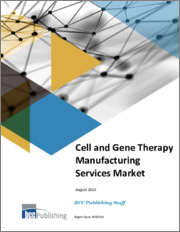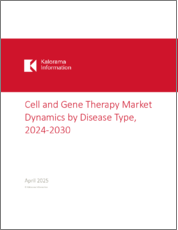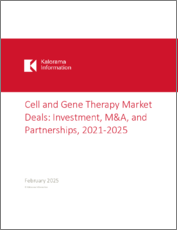
|
시장보고서
상품코드
1311834
세포 및 유전자 치료제 제조 서비스 시장Cell and Gene Therapy Manufacturing Services Market |
||||||
세계의 세포 및 유전자 치료제 제조 서비스 시장 규모는 2022년 49억 달러, 2023년 57억 달러에서 예측 기간 중 15.7%의 CAGR로 추이하며, 2028년에는 118억 달러 규모로 성장할 것으로 예측됩니다.
북미 지역은 2022년 22억 달러, 2023년 25억 달러에서 16.1%의 CAGR로 추이하며, 2028년에는 54억 달러 규모로 성장할 것으로 예측됩니다. 또한 아시아태평양은 2022년 11억 달러, 2023년 13억 달러에서 17.2%의 CAGR로 추이하며, 2028년에는 29억 달러 규모로 성장할 것으로 예측됩니다.
세계의 세포 및 유전자 치료제 제조 서비스 시장을 조사했으며, 시장 개요, 기술 배경, 법규제 환경, 시장 영향요인 및 시장 기회 분석, 신규 기술의 동향, 시장 규모의 추이·예측, 각종 구분·지역별 상세 분석, ESG 분석, 경쟁 구도, 주요 기업의 개요 등을 정리하여 전해드립니다.
목차
제1장 서론
제2장 요약·하이라이트
제3장 시장 개요·기술 배경
- 개요
- 유전자 추가 또는 증강
- 유전자 수정
- 유전자침묵(Gene Silencing)
- 제조
- 공급망
- 규제 상황
- 미국(FDA)
- 유럽
- 제조 위탁
제4장 시장 역학
- 시장에 영향을 미치는 요인
- 시장 촉진요인
- 시장 억제요인
- 시장 기회
제5장 신규 기술
- 신기술
- 자동화
- 디지털화
- 일회용 기술
- 신규 제조 모델
제6장 시장 내역 : 유형별
- 개요
- 세포치료
- 유전자 치료
- 세포치료 유형
- 자기 세포치료
- 동종 세포치료
- 벡터 유형에 기반한 세포 및 유전자 치료 유형
- 바이러스 벡터
- 비바이러스 벡터
제7장 시장 내역 : 용도별
- 개요
- 임상 제조
- 상업 제조
제8장 시장 내역 : 질환별
- 개요
- 암
- 희귀질환
- 기타 질병
제9장 시장 내역 : 최종사용자별
- 개요
- 제약회사 및 바이오테크놀러지 회사
- 학술연구기관
- 기타
제10장 시장 내역 : 지역별
- 개요
- 북미
- 미국
- 캐나다
- 유럽
- 영국
- 독일
- 프랑스
- 기타 유럽
- 아시아태평양
- 중국
- 일본
- 호주
- 기타 아시아태평양
- 기타 지역
제11장 지속가능성 : ESG 관점
- 개요
- CGT 제조에서의 ESG 실천
- 사례 연구 : ESG 도입의 성공 사례
- 결론
제12장 M&A·자금조달 전망·경쟁 구도
- 투자 전망
- M&A
- 전략적 구상
- 경쟁 분석
제13장 기업 개요
- CATALENT INC.
- CELL AND GENE THERAPY CATAPULT
- CHARLES RIVER LABORATORIES
- FUJIFILM DIOSYNTH BIOTECHNOLOGIES
- LONZA GROUP AG
- MERCK KGAA
- MILTENYI BIOTEC
- NIKON CELL INNOVATION CO. LTD.
- TAKARA BIO INC.
- THERMO FISHER SCIENTIFIC
- WUXI ADVANCED THERAPIES
Highlights:
The global cell and gene therapy manufacturing services market reached $4.9 billion in 2022, should reach $5.7 billion by 2023 and $11.8 billion by 2028 with a compound annual growth rate (CAGR) of 15.7% during the forecast period of 2023-2028.
North American cell and gene therapy manufacturing services market reached $2.2 billion in 2022, should reach $2.5 billion by 2023 and $5.4 billion by 2028 with a CAGR of 16.1% during the forecast period of 2023-2028.
Asia-Pacific cell and gene therapy manufacturing services market reached $1.1 billion in 2022, should reach $1.3 billion by 2023 and $2.9 billion by 2028 with a CAGR of 17.2% during the forecast period of 2023-2028.
Report Scope:
The scope of this study encompasses an investigation of cell and gene therapy manufacturing services. BCC Research analyzes the manufacturing services based on therapy type, application, disease, and end user. BCC determines the current market status in each segment, examines its impact on future markets, and presents growth forecasts over the next six years. The recent report provides a detailed analysis of the market's drivers, challenges, and opportunities. The report also covers market projections to 2028 and market share for key market players. The report includes the company profiles of the key players with detailed information about their business segments, financials, product portfolios, and recent developments. The report also provides the ESG perspective, emerging technologies, and investment outlook.
Report Includes:
- 34 data tables and 18 additional tables
- An overview of the global cell and gene therapy manufacturing services market
- Analyses of global market trends, with data from 2020-2022, estimates for 2023, and projections of compound annual growth rates (CAGRs) through 2028
- Highlights of the market potential and quantification of market based on therapy type, application, disease, and end-user
- A look into current technologies underlying the market as well as the effects new technologies will have on the market
- Coverage of clinical trials pipeline, partnership between pharmaceutical companies, and Contract Development & Manufacturing Organization (CDMO)
- Insights into investments from multiple stakeholders, and discussion on increasing focus on personalized medicine for rare and chronic conditions
- Information on recent mergers, acquisitions, collaborations, agreements, product launches, and expansions in the market and a relevant patent analysis
- Company profiles of major players within the industry, including Catalent, Charles River Laboratories, Lonza, Merck KGaA, and Thermo Fisher Scientific
Executive Summary
Summary:
The pharmaceutical industry is changing and moving away from a one-size-fits-all approach to a targeted and personalized approach, in which patients' own genetic information and immune systems are used to treat previously incurable diseases. Cell and gene therapies are different from the traditional biopharma products. Cell and gene therapies (CGT) are a novel therapeutic modality for a range of chronic and age-related conditions. These provide a fundamental treatment option for disease conditions that do not have a cure or cannot be treated with conventional drugs. Initially, cell and gene therapies were highly explored for oncology. However, the research is expanding into other disease areas.
Demand for cell and gene therapies is high and there is a lot of R&D in this segment supported by huge investments and funding for CGTs. According to the Alliance for Regenerative Medicine 2022 report, CGT research raised nearly $19.9 billion in 2020, $22.7 billion in 2021 and $6.3 billion in the first half of 2022 (H1 2022) and overall investment of $12.6 billion. The number of clinical trials and regulatory approvals for cell and gene therapies will increase over the coming years. The FDA estimates that by 2025, it will approve 10-20 cell and gene therapy products per year, and it is forecasted that by 2030 there will be around 75 approved therapies.
Notably, even though awareness and demand are increasing, there is a lack of supply. This is mainly due to limited manufacturing capacity and complex supply chain. Hence, it is important that the organizations scale-up to meet the supply chain requirements. Also, due to stringent, expensive, and complex manufacturing processes, most of the small and medium sized pharma and biotech companies are engaging with contract development and manufacturing organizations (CDMO). This is a contributing factor to the growth of the CGT CDMO's.
Increasing investments, capacity expansions for clinical and commercial manufacturing, increasing prevalence of chronic diseases and focus on rare diseases, and increased healthcare expenditure drive the cell and gene therapy manufacturing services market. Accelerated approvals in recent years, coupled with technological advancements (development of off-the-shelf products, automations, application of advanced gene editing techniques like CRISPR), will lower the complexities involved around manufacturing CGTs and will attract many pharma and biotech companies to enter the market, thus contributing to the market in the forecast period.
The global market for cell and gene therapy manufacturing services was estimated to be $4.9 billion in 2022 and is expected to increase to $11.8 billion by 2028, growing at a CAGR of 15.7%. The cell and gene therapy manufacturing services market is segmented based on application, type, disease, end user, and region. Major players in the market are Lonza, FUJIFILM Diosynth, Charles River, Thermo Fisher, and Merck KGaA.
The North American region has the highest share, followed by Europe. Extensive R&D activities take place in the region, there are major players present, plentiful funding, and increasing prevalence of chronic diseases. All these factors contribute to growth in the market. Based on application, the cancer segment has the highest share
Table of Contents
Chapter 1 Introduction
- Study Goals and Objectives
- Reasons for Doing This Study
- Scope of Report
- Information Sources
- Methodology
- Geographic Breakdown
Chapter 2 Summary and Highlights
- Market Overview
Chapter 3 Market Overview and Technology Background
- Overview
- Gene Addition or Augmentation
- Gene Correction
- Gene Silencing
- Manufacturing
- Supply Chain
- Regulatory Landscape
- U.S. (FDA)
- Europe
- Outsourcing of Manufacturing
Chapter 4 Market Dynamics
- Factors Affecting the Market
- Market Drivers
- Increasing Investment and Funding for CGT Development
- Capacity Expansions for Clinical and Commercial Manufacturing
- Rising Prevalence of Chronic Diseases and Focus on Rare Diseases
- Increasing Strategic Collaborations and Acquisitions
- Market Restraints
- Complex Manufacturing and Supply Chain
- Lack of Skilled Workforce
- Regulatory Hurdles
- Market Opportunities
Chapter 5 Emerging Technologies
- Introduction
- Emerging Technologies
- Automation
- Digitalization
- Single-Use Technologies
- Emerging Manufacturing Models
Chapter 6 Market Breakdown by Type
- Overview
- Cell Therapy
- Gene Therapy
- Cell Therapy Types
- Autologous Cell Therapy
- Allogeneic Cell Therapy
- Cell and Gene Therapy Types Based on Vector Type
- Viral Vectors
- Nonviral Vectors
Chapter 7 Market Breakdown by Application
- Overview
- Clinical Manufacturing
- Commercial Scale Manufacturing
Chapter 8 Market Breakdown by Disease
- Overview
- Cancer
- Rare Diseases
- Other Diseases
Chapter 9 Market Breakdown by End User
- Overview
- Pharmaceutical and Biotechnology Companies
- Academic and Research Institutes
- Others
Chapter 10 Market Breakdown by Region
- Overview
- North America
- U.S.
- Canada
- Europe
- U.K.
- Germany
- France
- Rest of Europe
- Asia-Pacific
- China
- Japan
- Australia
- Rest of Asia-Pacific
- Rest of the World
Chapter 11 Sustainability: An ESG Perspective
- Overview
- ESG Practices in the CGT Manufacturing Industry
- Case Studies: Examples of Successful ESG Implementation
- Conclusion
Chapter 12 M&A, Funding Outlook and Competitive Landscape
- Investments Outlook
- Mergers and Acquisitions
- Strategic Initiatives
- Competitive Analysis
Chapter 13 Company Profiles
- CATALENT INC.
- CELL AND GENE THERAPY CATAPULT
- CHARLES RIVER LABORATORIES
- FUJIFILM DIOSYNTH BIOTECHNOLOGIES
- LONZA GROUP AG
- MERCK KGAA
- MILTENYI BIOTEC
- NIKON CELL INNOVATION CO. LTD.
- TAKARA BIO INC.
- THERMO FISHER SCIENTIFIC
- WUXI ADVANCED THERAPIES



















